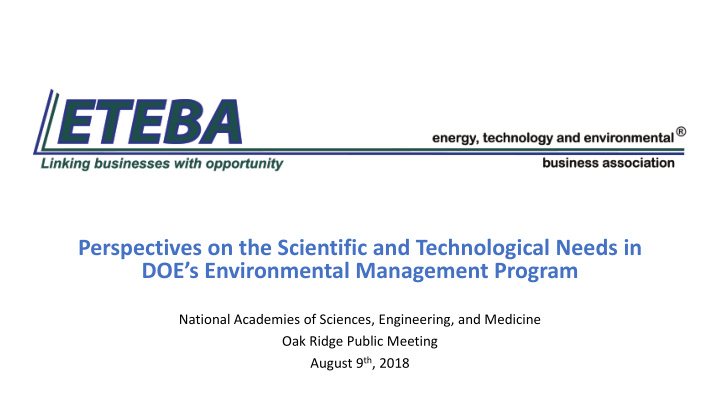



Perspectives on the Scientific and Technological Needs in DOE’s Environmental Management Program National Academies of Sciences, Engineering, and Medicine Oak Ridge Public Meeting August 9 th , 2018
Statement of the NAS Task (Mandated by Congress; Sponsored by DOE EM) The National Academies of Sciences, Engineering, and Medicine will conduct an independent assessment of technology development efforts within the U.S. Dept. of Energy’s Office of Environmental Management. This assessment will involve the following: 1. A review of DOE-EM’s technology development efforts, including an assessment of the processes by which technologies are identified and selected for development.
Statement of the NAS Task (cont.’d) 2. A review and assessment of types of technologies and/or alternative approaches for the DOE-EM cleanup program that could: a. Reduce long-term costs b. Accelerate schedules c. Mitigate uncertainties, vulnerabilities, or risks, or d. Otherwise significantly improve the cleanup program.
ETEBA Background • ETEBA is a trade association comprised of ~150 corporate and affiliate members. • Eastern Chapter based in Oak Ridge; Western Chapter based in New Mexico. • Our mission is 3-fold: • 1) Keep members informed of news and developments across the DOE Complex. • 2) Advocate on behalf of our members. • 3) Facilitate the connection between our members and business opportunities. ETEBA member companies are critical components of DOE’s Environmental Management program, both as primes and subs.
Some challenges associated with technology deployment: • DOE has a long history of env. Tech. assessment and deployment (e.g., Technology Readiness Assessments), but funds have been declining. • Contractual relationship and performance metrics between DOE, prime contractors, and subcontractors may not be conducive to new technology deployment. • Risk aversion - the overriding pressure to complete environmental cleanup with tried and true technologies that minimize risk.
Some challenges associated with technology deployment (cont.’d): • A paradox – developing, testing, and/or deploying potentially “faster and cheaper” technologies isn’t a good fit in a “faster and cheaper” cleanup environment. • Regulatory and stakeholder involvement and approval can slow the process. • Compliance agreements and schedules may not facilitate technology development and deployment. • Who pays for testing, evaluation, and/or deployment – EM or Science?
Recommendations re: EM’s Science and Technology Needs: 1. A simplified assessment process for more straightforward and proven technical capabilities that address less complex problems. 2. A specific entity (lab?) to which the private sector can submit unsolicited proposals and specific technological capabilities for consideration. 3. This entity must be technically capable of evaluating the efficacy and economic impact (short-term and long-term) of the technology.
Recommendations (cont’d): 4. Increased R&D funding specifically focused on EM problems. 5. Financial incentives to incentivize primes and subcontractors to test and assess innovations (as has been done in the past). 6. Minimize the financial risk for primes or subcontractors who test innovative approaches and technologies.
Other Random Thoughts/Questions: • Will the new EM/OS organizational structure facilitate the identification and deployment of technologies? • How is the research and technical expertise at the labs being translated to the field? • Should there be a tech transfer “sub-program” specifically focused on transferring environmental tech. innovations to the private sector? • Should there be a single “clearinghouse” for EM technological innovations? • To what degree are the labs communicating re: tech R&D?
How could ETEBA help? • Members offer a wide range of expertise and experience in cleanup programs across the Complex. • Reach out to individual members for specific expertise and capabilities. • Serve as a resource/clearinghouse for member capabilities. • Host public information and technical forums. • Reach out to affiliate organizations (e.g., OCNI) for expertise.
Collectively, E ETEBA me memb mber co comp mpanies compr prise a an n exceptiona nal po pool o of e environme nmental techni hnical e expe pertise, a appl pplied e expe perience, a and nd lessons ons l learne ned that can be a resou ource f for or de developing ng a and/ nd/or pr promoting ng ne new and nd pr proven n technol olog ogies.
Recommend
More recommend